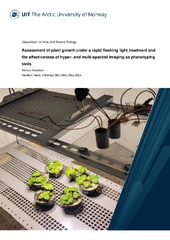Assessment of plant growth under a rapid flashing light treatment and the effectiveness of hyper- and multi-spectral imaging as phenotyping tools
Author
Andersen, MarcusAbstract
Controlled environment agriculture, such as greenhouses, offers a promising solution to enhance local food production in Nordic regions, where long winters and limited natural light hinder year-round cultivation. This study investigates the effects of a rapid flashing light system on the growth and chlorophyll content of woodland strawberry Fragaria vesca, aiming to optimize energy use in greenhouse production. The experiment compared continuous to a pulsed light treatment, with the latter operating at a frequency of 16.67 kHz with a duty ratio of 33%. Multispectral and hyperspectral imaging were employed as non-invasive phenotyping tools to assess plant traits, including biomass, NDVI, and chlorophyll content. While multispectral data revealed a statistically significant but small difference in biomass and NDVI between treatments, no significant differences were observed in total chlorophyll content or the Chl a to Chl b ratio. Hyperspectral indices, including CARI, MCARI, and MTCI, showed weak correlations with lab-measured chlorophyll levels, highlighting the need for further optimization of vegetation indices for F. vesca. The results suggest that the flashing light system may not produce meaningful distinctions under the current experimental conditions, emphasizing the importance of improving the experimental design, such as increased replicates, duty cycles, and PPFD levels. This study contributes to the development of sustainable greenhouse practices by integrating advanced imaging technologies with innovative lighting strategies.
Publisher
UiT The Arctic University of NorwayMetadata
Show full item recordCollections
Copyright 2025 The Author(s)


 English
English norsk
norsk
